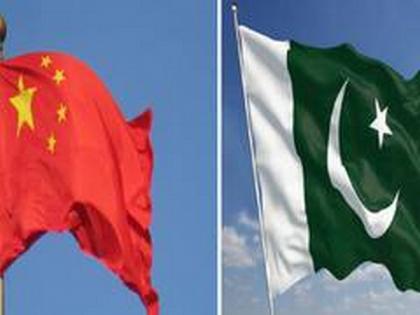China-indebted Pakistan looking down the abyss: Report
By ANI | Published: April 13, 2023 11:46 PM2023-04-13T23:46:10+5:302023-04-13T23:50:25+5:30
New Delhi [India], April 13 : Last month, China and Pakistan celebrated the tenth anniversary of the USD 64 ...

China-indebted Pakistan looking down the abyss: Report
New Delhi [India], April 13 : Last month, China and Pakistan celebrated the tenth anniversary of the USD 64 billion China-Pakistan Economic Corridor (CPEC). But the joy ended soon after Syed Tariq Fatemi, special assistant to Pakistan's prime minister Shehbaz Sharif wrote a letter with a warning, reported Asia Times.
"Overdue payments to the Chinese IPPs [the independent power plants built and operated by China in Pakistan] currently stand at USD 1.5 billion," he wrote in a message sent to Pakistan's Planning Commission.
"This is causing huge concern among Chinese businesses," the message said further.
Fatemi's message, sent to Pakistan's Planning Commission, referred to three power plants in Hub, Sahiwal, and Port Qasim. Hub is in Pakistan's Balochistan; Sahiwal and Port Qasim are in Punjab and Sindh Provinces, respectively.
The much-vaunted CPEC is not going quite as planned, and it's not just the recent economic and political crises in Pakistan that have queered the pitch. The CPEC's fate has once again raised serious questions about Pakistan's state capacity and internal stability. Its deep-seated problems have now spilt beyond the economic sphere to the social.
They have even begun to affect its "all-weather ally" China and the CPEC.
Fatemi's message highlighted two problems. First, Pakistan didn't have enough foreign exchange to buy the grade of coal these power plants require. Second, it had no money to pay its debts to China, its biggest benefactor, reported Asia Times.
A recent IMF report estimated that out of USD 126 billion in overseas debt, Pakistan owes about USD 30 billion to China.
Other gas-based power plants are facing a crisis, too, with Pakistan unable to import LNG, although Balochistan has abundant reserves that are inefficiently tapped. Over half the country is facing a severe power crisis. Both businesses and people are suffering.
The CPEC involved much more than rail and road infrastructure. Besides the trade corridor linking the port of Gwadar in Balochistan to China's Xinjiang province, the CPEC was meant to build the power plants required to electrify large parts of a country long starved of that basic good.
There were plans to create special economic zones to boost Pakistan's exports and provide global transit hubs, and several mining projects, notably in troubled Balochistan.
The CPEC projects were meant to add between 2 per cent and 2.5 per cent to Pakistan's economy and create at least 2.3 million local jobs by 2030. Those targets look distant. Ten years later, barely 46,500 jobs have been created.
Many, including China, blame the resistance groups, insurgents, and terrorists who operate in Pakistan.
The real problem is Pakistan is unable to manage its economic and administrative affairs efficiently enough to build and generate adequate returns from complex projects like the CPEC, reported the Asia Times.
Much-touted contracts at Reko Diq, in the Chagai hills of Balochistan, involved Chinese, Australian and Canadian compes mining for copper and gold. They are at a standstill.
Even the showpiece of the CPEC, Gwadar port, is supported by power supplied by Iran through a nearly thirty-year-old arrangement whereby some of Pakistan's western provinces were electrified through imported power.
Recently Munir Mengal, president of the Baloch Voice Association, charged the federal government in Islamabad with "creating propaganda." None of the CPEC projects had been completed, he alleged.
Sources say that completion dates have been advanced and the completed projects are operating at half-capacity, like most power plants. Worse, Pakistan's financial crisis may force it to consider further delaying projects unless China steps in with the needed capital and agrees to accept deferred payment once the projects are up and running.
Government data shows that seven projects in the infrastructure sector have been completed. Six more are to be completed by 2025, and another 12 are meant to be completed by 2030. None of the nine special economic zones, including the one at Gwadar meant to develop both the port and the city as a major industrial and transit hub, are finished.
Sources in Balochistan and Sindh argue that the deadlines aren't feasible, not just financially, but because of the violent local resistance. The state of Pakistan's industry is exacerbating questions about the feasibility of infrastructure projects.
The lifecycle costs are far more than what's required to build a road, railway, or bridge. They require constant streams of revenue. The IMF warned in April last year that Pakistan faced "de-industrialization." This decline would be worse under today's economic scenario.
The lack of foreign exchange is telling, both about Pakistan's relationship with Chinese compes and its relationship with other multinationals. With about USD 4.3 billion in foreign exchange reserves, enough to cover just one month of imports, the country's central bank has clamped down on overseas repatriation of funds, even those legitimately accruing to parent compes abroad, like dividends.
State Bank of Pakistan data shows that repatriation dropped to USD 182.5 million in July-December of the financial year 2022-23 from USD 794 million the prior year. Forex reserves are not being supported by economic earnings but by overseas loans, largely from China.
In late February, China provided a USD 500 million loan. Recently the Industrial and Commercial Bank of China approved the rollover of a USD 1.3 billion loan.
Disclaimer: This post has been auto-published from an agency feed without any modifications to the text and has not been reviewed by an editor
Open in app